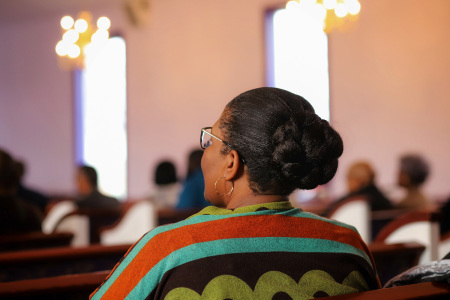Black churches suffered more but adapted better during pandemic: study

Compared to white and multiracial churches, majority-black congregations suffered more from the impact of the COVID-19 pandemic but appear to have adapted better to the challenges presented by the virus, a new study shows.
In "Understanding The Pandemic Impact on Black and Multiracial Congregations," published by the Hartford Institute for Religion Research this month, researchers found that while white, multiracial and majority-black churches were negatively impacted by the pandemic and lockdowns in the last three years, drops in attendance, finances and clergy well-being were particularly pronounced for predominantly black congregations because they were compounded by structural racism.
Structural racism, according to the American Medical Association, “refers to the totality of ways in which societies foster racial discrimination through mutually reinforcing systems of housing, education, employment, earnings, benefits, credit, media, health care and criminal justice.”
“Since the EPIC study began in 2021, our reports have shown how the pandemic has impacted congregations on attendance, vitality, volunteers, religious education, and innovative ways those congregations have adapted. For majority-black congregations, the combined effect of the pandemic and ongoing structural racism in the United States multiplies this experience,” the researchers, led by Scott Thumma, professor of sociology of religion at Hartford International University for Religion and Peace and director of the Hartford Institute for Religion Research, found.
“External factors outside of the pandemic, such as income inequality, redlining, disparate education, and access to resources, multiply the effects of the pandemic on black communities. Moreover, internal factors resulting from said influences have also played a part in clergy well-being,” they added. “The burdens of systematic racism persist in both individual and collective systematic ways in majority-black and multiracial congregations.”
When comparing financial health of the congregations from 2018 to spring 2023, 49% of majority-white congregations said their financial health has stayed the same, while only 41% of predominantly black congregations said their financial status was the same.
Data collected in spring 2023 also showed that 34% of majority-black congregations reported that their financial health decreased since 2018, compared to 28% multiracial and 29% in majority-white congregations.
Perhaps due to additional giving or federal relief funding during the pandemic, researchers found that 25% of predominantly black churches were also found to be thriving financially compared to 24% of multiracial and 22% of majority-white congregations.
“Perhaps for some congregations, additional congregant giving, and federal relief provided during COVID subsidized the financial burdens across all congregations. Majority-black congregations still seemed to struggle to reach financial stability. This cycle of instability and dependence speaks to the systemic issues facing majority-black congregations and the intersections of race and socioeconomic class,” the researchers said.
Despite their struggles during the pandemic, the study found that majority-black congregations which have ‘historically exercised great innovation, resilience, and adaptability” applied these same survival skills to continue fellowshipping when the pandemic interrupted in-person meetings.
“From using technology like conferencing and social media to promote fellowship and worship to providing hybrid programming to all age groups, majority-black congregations have led the pathway notwithstanding, participating in COVID-19 mitigation initiatives, like becoming vaccination sites,” the researchers said. “Black clergy’s commitment to their call and subsequent congregations’ resilience throughout the pandemic has been and continues to be unwavering.”
Predominantly black churches were also found to have provided more opportunities for their congregants to pray together than other churches in the study.
“Spring 2023 results show that 41% of black congregations offered hybrid prayer gatherings, at approximately four times the rate of multiracial and majority white congregations,” the study said. “This may highlight the zealousness to gather, and especially for prayer, which remains a frequent practice and coping mechanism among black adults.”
Contact: leonardo.blair@christianpost.com Follow Leonardo Blair on Twitter: @leoblair Follow Leonardo Blair on Facebook: LeoBlairChristianPost





















